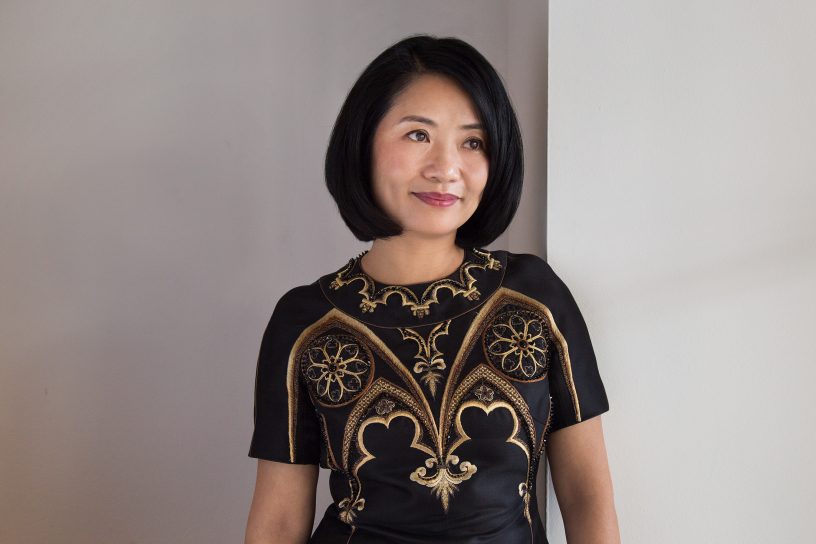Guo Pei has always seen the light—even when her world has been full of darkness.
The celebrated fashion designer was born during China’s Cultural Revolution, a time when the country was purged of the Four Olds: customs, culture, habits, and ideas. Utilitarian Mao suits were considered the only politically correct form of clothing, and the concept of fashion was practically nonexistent. Dresses were not hung in the wardrobes of young girls, patterns were not stitched, and silk was not touched.
But Guo had her imagination. She was never disillusioned by the simple communist uniform of her childhood because she was able to escape to a world that her grandmother described for her, seduced by words that painted pictures of flowers and butterflies. Guo’s grandmother taught her to dream in colour and to express a beauty that could only come from the heart, which is how her love of fashion began. “I listened to stories with my eyes closed,” she recalls in her native Mandarin, speaking through a translator. “My imagination was beautiful … It’s always been with me.”
With each word she speaks, a smile beams across her face. She lights up the Vancouver Art Gallery room in which she sits; she is the woman of the hour, after all, the subject of the gallery’s debut exhibition dedicated solely to the art of fashion. “Guo Pei: Couture Beyond” is a look into the breathtaking universe of mainland China’s only haute couturier, and the designer has come to Vancouver for the very first time in honour of her exhibit’s Canadian premiere.
“My work is very much based on my emotions,” she says of her grandiose style, which creates silhouettes that synthesize traditional skill with modern feeling. “It’s an expression of love. There’s a lot of passion behind it.” She is a master at fusing the worlds of ancient and contemporary production, often using materials that celebrate Chinese history and mythology. Finding inspiration in museums and galleries, her garments are comparable to architecture—high-fashion gowns with gothic and neoclassical shapes. “We are very much touched by the beauty and the work of the achievements of the previous dynasties and European and Asian historical periods,” she says. “For couture designers, there is a greater responsibility. Couture needs to be more real, more sincere, because it represents history, culture, emotion, and contemporary lifestyle.” She pauses, smiles. “It’s art.”
Guo’s art, then, is complex; she suggests that “detail is the wisdom.” Polished with a creativity that can only be shaped by the imagination, all of her pieces are executed painstakingly by hand. Using a range of embroidery techniques (a signature of her atelier), designs take the form of theatrical fantasies, enriched with imperial glamour, rich textures, and expansive outlines. Guo’s extraordinary details are achieved through the thousands of hours of work dedicated to each dress; 500 skilled artisans produce three to four thousand custom garments each year.
This craftsmanship had already made her popular in China, but it was in 2015 that North America took notice. She was one of a few contemporary Chinese designers chosen to have pieces shown at the Metropolitan Museum of Art Costume Institute’s “China: Through the Looking Glass” exhibition, and to that year’s Met Gala all eyes were on pop star Rihanna, who floated along the red carpet in the designer’s canary-yellow silk coronation cape design. With a 16-foot train trimmed in fox fur and embroidered with 24-karat-gold thread, the 55-pound masterpiece took two years to create, but only a few seconds to make headlines. And although she shyly admits to not knowing who Rihanna was prior to the event, the designer says she is “very grateful” to the singer, who brought the dress (which is part of the Vancouver show) alive with her “inner beauty.” Never one to seek fame, what matters most to Guo is her effort “to create perfect work.”
So it’s no wonder that in 2016, Guo was invited into the official Chambre Syndicale de la Haute Couture in Paris. “I was very happily surprised,” she recalls of the exclusive honour from the French governing body of haute couture. Not only was she from a country not usually known for couture, but she was accepted upon her first application—another rare feat.
Reflecting on her pieces in the Vancouver exhibit, which runs until January 20, 2019, she insists that those who come to see it do not need to be familiar with the world of fashion. “It’s like a painting or a piece of music,” she explains patiently. “Not everyone will understand the exact inner soul of that piece of work, but whatever people can feel and understand is good enough.” This allows the viewer’s imagination, just like Guo’s, to run free.
